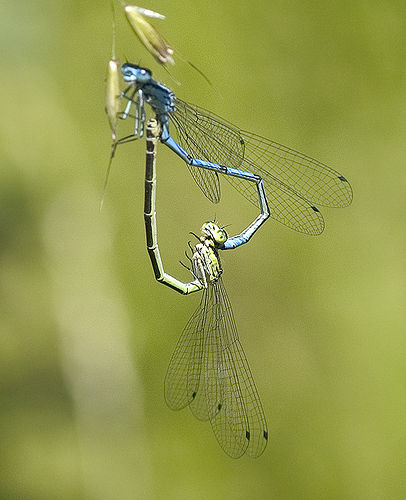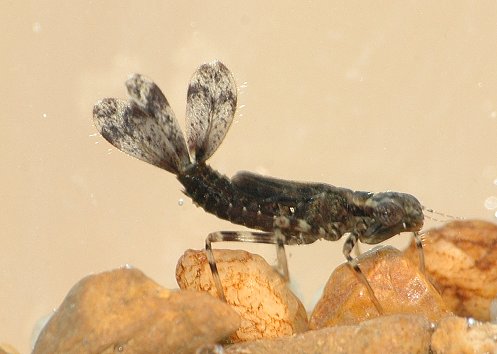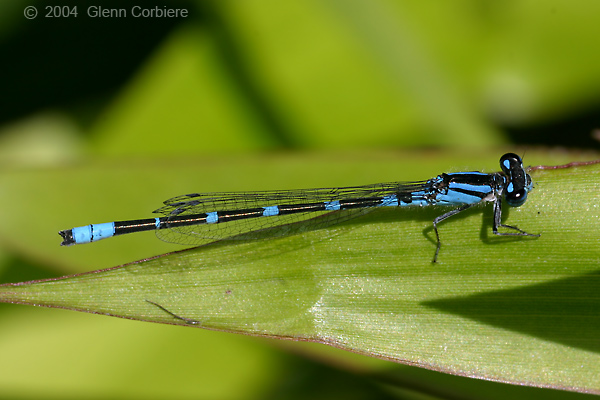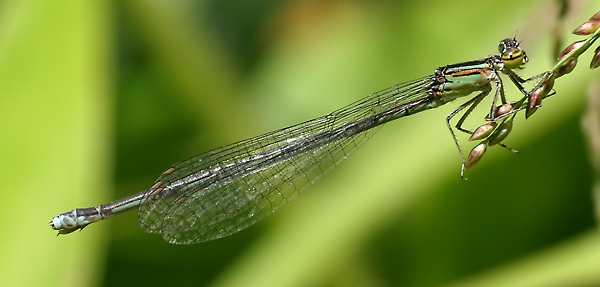Reproduction
Damselflies are
hemimetabolous (“half change”) organisms, meaning they
undergo incomplete metamorphosis during their life cycle.
During incomplete metamorphosis, the organism does not go
through larva and pupa stages; instead, it goes through multiple
molts during a nymph stage.
 Depending on
the species, adult damselflies are most active
during spring,
summer, or fall. Damselfly pairs
often fly while mating and may remain clasped in tandem for
hours. The male damselfly grasps the female behind her
head with claspers on his abdomen; he then deposits sperm by
bending his abdomen forward since the male sex organ is in the
front part of the abdomen. The female loops her abdomen to
receive the sperm from the male. It is common for damselflies
to produce one generation each year, but it may take 1-2 years
to complete the life cycle.
Depending on
the species, adult damselflies are most active
during spring,
summer, or fall. Damselfly pairs
often fly while mating and may remain clasped in tandem for
hours. The male damselfly grasps the female behind her
head with claspers on his abdomen; he then deposits sperm by
bending his abdomen forward since the male sex organ is in the
front part of the abdomen. The female loops her abdomen to
receive the sperm from the male. It is common for damselflies
to produce one generation each year, but it may take 1-2 years
to complete the life cycle.
Once fertilized, females usually lay eggs by dipping their abdomen into water; the chosen habitat for the eggs can vary widely from underwater vegetation, above water vegetation, water-filled cavities, or bromeliads.
 A naiad (nymph) emerges from the egg to enter the aquatic
nymphal stage which
can last anywhere from a few weeks to almost five years, never
leaving the water. The naiad goes through 10 – 15
instars, or molts, to grow before
being mature enough for the next stage; after each instar, the
naiad becomes darker. During each molt, the exoskeleton
hardens, and the wings develop as buds on the thorax until they
are functional. Developmental rates are intimately related
to seasonal cues which send signals to hormones in the naiad.
When naiads hatch late from their eggs, their development time
decreases; this results in a larger adult body size because the
growth rate increased by such a large amount. At the other
end of the spectrum, larva that hatch early can afford to slow
their development rate because they lack the motivating pressure
to maximize growth rate. Naiads slow their growth to also
decrease mortality risk.
A naiad (nymph) emerges from the egg to enter the aquatic
nymphal stage which
can last anywhere from a few weeks to almost five years, never
leaving the water. The naiad goes through 10 – 15
instars, or molts, to grow before
being mature enough for the next stage; after each instar, the
naiad becomes darker. During each molt, the exoskeleton
hardens, and the wings develop as buds on the thorax until they
are functional. Developmental rates are intimately related
to seasonal cues which send signals to hormones in the naiad.
When naiads hatch late from their eggs, their development time
decreases; this results in a larger adult body size because the
growth rate increased by such a large amount. At the other
end of the spectrum, larva that hatch early can afford to slow
their development rate because they lack the motivating pressure
to maximize growth rate. Naiads slow their growth to also
decrease mortality risk.
After the naiad completes its instars, it swims to the
water’s edge and crawls out of the water onto a plant.
This often occurs as the sun warms the habitat after sunrise;
this timing helps the damselfly avoid dew because dew can be
fatal if it
touches the damselfly’s wings while it emerges from
its naiad
 form. After the naiad’s skin dries, the skin
splits along the wing case as the adult strains to
pull away
from
the old skin. The adult damselfly’s new legs harden while
attached to the plant, and the wings slowly expand as fluids
from the abdomen pump them open.
form. After the naiad’s skin dries, the skin
splits along the wing case as the adult strains to
pull away
from
the old skin. The adult damselfly’s new legs harden while
attached to the plant, and the wings slowly expand as fluids
from the abdomen pump them open.
Finally, the wings dry, and the adult damselfly can fly into
its terrestrial environment to complete the rest of its life.
The damselfly can exist in its adult form for several weeks or
months before mating and dying.
Want to follow damselflies as they complete their life cycle? Sure you do! Just follow this link.
Damselflies cannot be the only organisms that live near water! Find out more about the other aquatic organisms that live with (and sometimes eat) damselflies.
